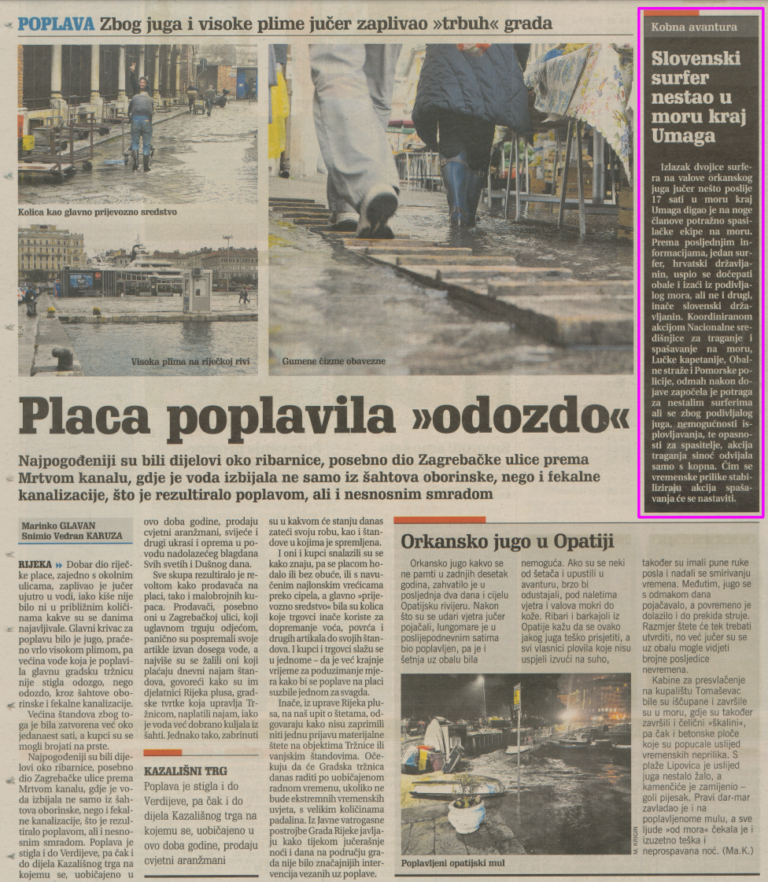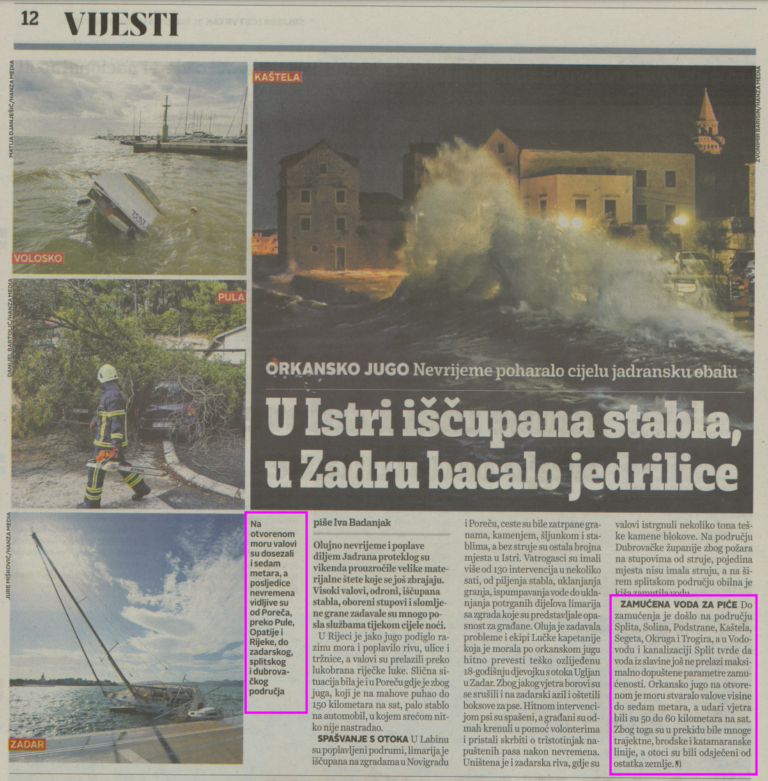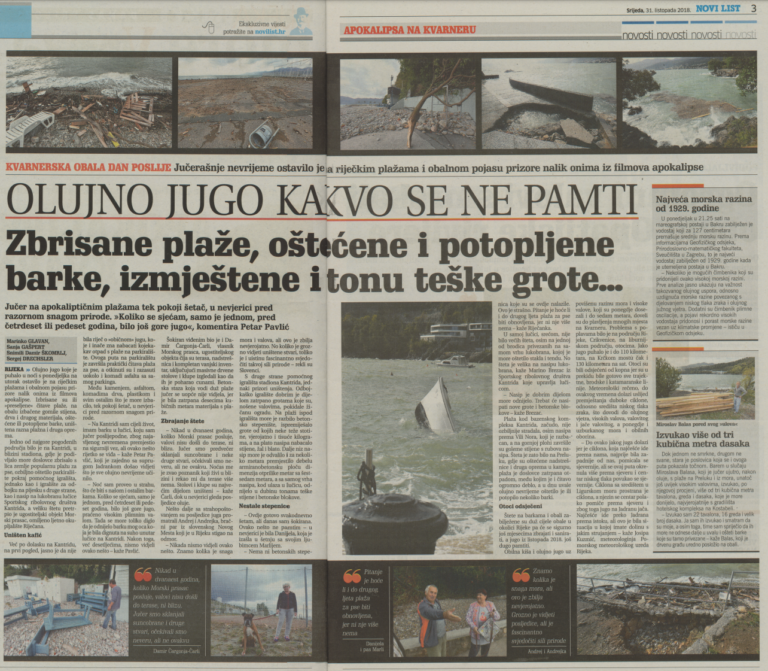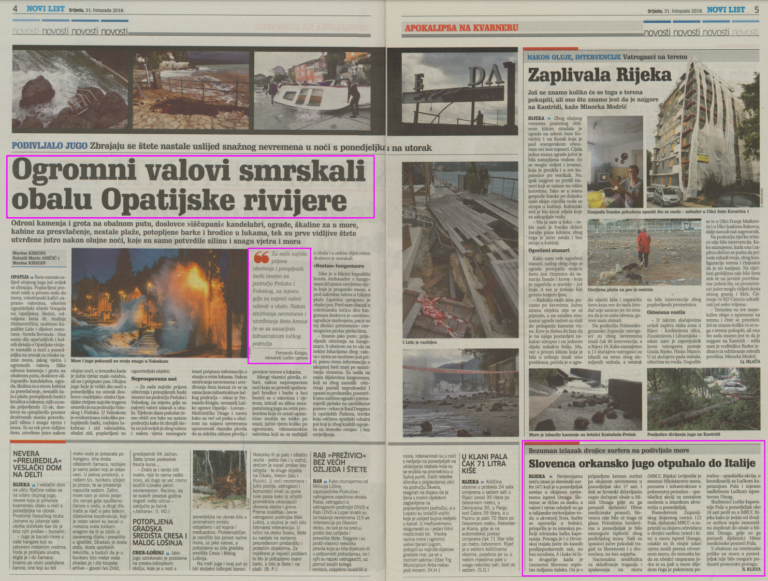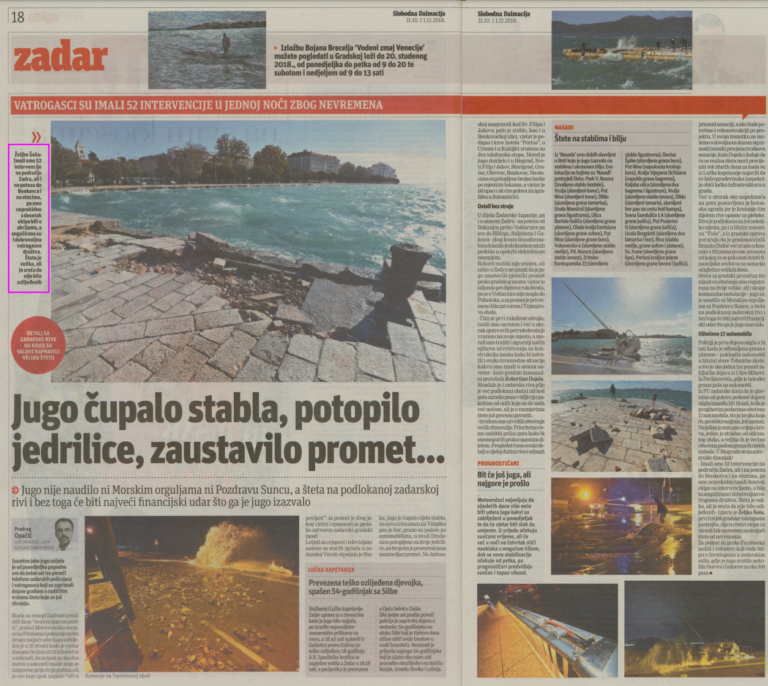Episode 21, 29 October 2018
Analysis
Description
Meteorological background
On 26 October, the meteorological conditions over the Mediterranean featured a weakening surface-based anticyclone over the eastern Mediterranean, while in higher levels a trough, carrying colder air, was extending southward from northern Europe toward the Iberian Peninsula.
On 27 October, the trough advanced further south, creating a strong southwesterly flow in the upper atmosphere over the Adriatic, which brought warm air to the region. This trough was linked to a surface cyclone over the Baltic Sea, whose frontal system extended to the Alps. This setup led to the formation of a secondary cyclone in the Ligurian Sea, generating a strong southeasterly wind across the Adriatic.
On 29 October, the surface cyclone over the Ligurian Sea deepened, with pressure in the center dropping to 985 hPa, and moved northward, accompanied by a cold front passing over the Adriatic. The southeastern wind, already strong on 28 October, intensified to hurricane-like strength on 29 October. However, it weakened slightly by the peak of the flood as the system shifted northward and an anticyclone from the east began influencing the region.
Sea-level evolution
On 29 October (20:00 UTC), the sea level in Bakar rose to 97 cm above the long-term average. The overall sea-level maximum occurred during the negative phase of tide (diurnal neap tide), which contributed -12 cm and thus reduced the peak. Although 21.2-hour oscillations were present in the basin before the peak, they were weak and had dissipated by the time of the major maximum. As a result, synoptic component can be attributed almost entirely to a storm surge. This storm surge was driven by a strong atmospheric pressure gradient and sustained, extreme-speed Sirocco winds over several days, contributing 61 cm to the total sea-level maximum.
The remaining sea-level rise resulted from processes acting on other time scales (refer to Figure 1 in the Introduction for details): high-frequency oscillations added 12 cm, planetary-scale variability contributed 23 cm, and long-term sea-level change added 13 cm.
In summary, the flood was caused by positive contributions from all processes except tide, which had a negative effect, with synoptic component being the most significant. The flood could have been significantly stronger – approximately 30 cm higher – if the cyclone had passed a few hours earlier during tidal maximum.
Newspaper reports
Many newspapers, national and local, reported on this epizode for several days. Intriguing is the story about a surfer who was blown from the Croatian to the Italian coast while trying to surf the waves caused by the Sirocco (reported in Novi list and Slobodna Dalmacija). The story ended happily for the surfer. Here are excerpts from these texts.
Jutarnji list, 29 October 2018
Problems The severe storm led to considerable traffic problems, traffic was partially suspended and numerous islands remained cut off from the mainland due to the suspension of ferry services. According to the ferry companies and the HAK (Croatian Traffic Service), ferries to Hvar, Brač, Korčula, Žirje, Zlarin, Cres, Mali Lošinj, Rab and other islands were suspended yesterday. Due to the strong Sirocco, the A6 Rijeka-Zagreb highway between Kikovica and Delnice was open only for cars, while other vehicles were diverted to the old road. Rain and strong winds slowed traffic on the A1 Zagreb-Split-Ploče highway, according to HAK.
Novi list, 30 October 2018
A deadly adventure: Slovenian surfer disappeared in the sea near Umag The sufing trip of two surfers on the Sirocco waves yesterday shortly after 5 p.m. in the sea near Umag has kept the members of the search and rescue team at sea on their toes. According to the latest information, one of the surfers, a Croatian citizen, managed to reach the shore and save himself from the raging sea, but not the other, a Slovenian citizen. With the coordinated action of the National Center for Search and Rescue at Sea, the Port Authority, the Coast Guard and the Maritime Police, the search for the missing surfer began immediately after the report, but due to the rough south, the impossibility of setting sail and the danger to the rescuers, the search operation took place only from the shore yesterday evening. The rescue operation will continue as soon as the weather stabilizes.
Jutarnji list, 31 October 2018
On the open sea, the waves reached up to seven meters, and the consequences of the storm are visible from Poreč via Pula, Opatija and Rijeka to the areas of Zadar, Split and Dubrovnik.
Contaminated drinking water
The pollution occurred in the area of Split, Solin, Podstrana, Kaštela, Seget, Okrug and Trogir. According to ‘Vodovod i kanalizacija Split’, the water from the tap does not yet exceed the maximum permissible parameters for pollution. The sirocco caused 7 meter high waves on the open sea, and the wind gusts were 50-60 km/h. As a result, many ferry, boat and catamaran lines were disrupted and the islands were cut off from the rest of the country.
Novi list, 30 October 2018 (pages 4 and 5)
Huge waves smashed the coast of the Opatija Riviera At the moment we have the most reports of damage and sunken boats in the area of Preluk and Voloski, where the highest waves hit the coast. After the storm has calmed down and the damage has been assessed, the infrastructure of the harbor area will be restored – Fernando Kirigin, director of the port authority.
Slovenian was blown to Italy by the Sirocco wind The Slovenian surfer (47) was incredibly lucky when he disappeared in a storm off Umag on Monday. The Slovenian held on to his board and was carried by the waves and the wind into Italian territorial waters near Trieste. The port authority in Trieste informed the Istrian police that the surfer is recovering in hospital. The search also continued in Croatia until yesterday afternoon, but without any results. And how could it be otherwise when the (un)lucky Slovenian has drifted miles away.
Slobodna Dalmacija, 31 October 2018 (page 18)
Željko Šoša: We had 52 interventions in the Zadar area, but also on the route to Benkovac and on the islands, so we were constantly on duty with a dozen teams, and the volunteer fire departments were also deployed. The damage is extensive, but fortunately no one was injured.

